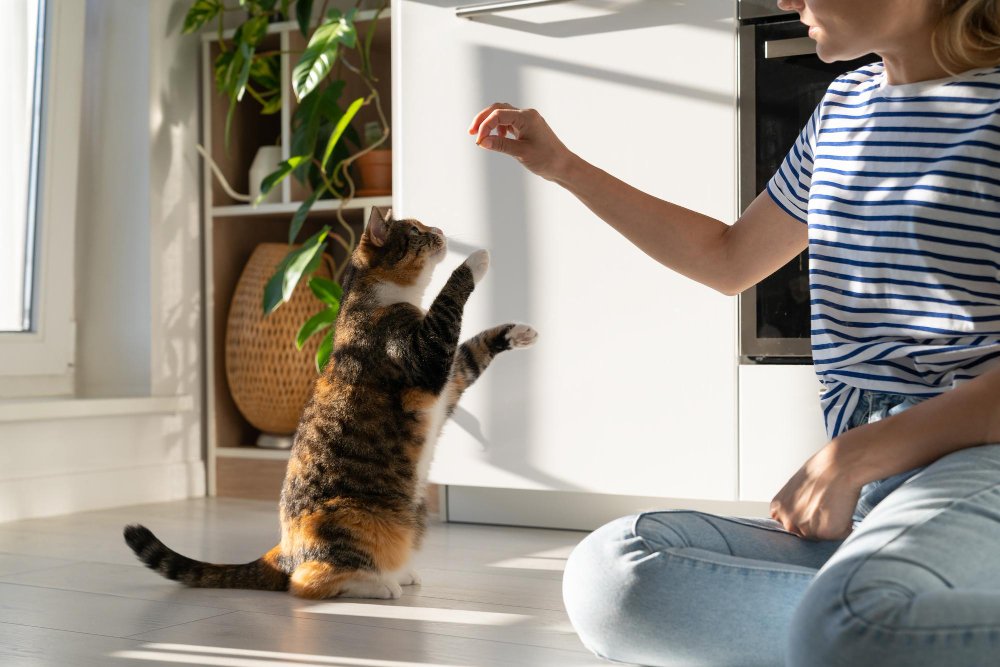Cat Behavior Training is a nuanced art that requires a deep understanding of our feline companions. By uncovering and harnessing their instinctual behaviors, we can develop effective training strategies that not only enhance our relationship with our cats but also contribute to their overall well-being.
Understanding Your Cat’s Natural Behaviors
Cats have a rich and complex set of natural behaviors that are rooted in their instincts. By understanding these behaviors, you can create a training environment that not only enhances your cat’s physical and mental well-being, but also strengthens the bond between you and your feline friend.
Instinctual Hunting
One of the most fundamental behaviors in cats is hunting. Even though our domesticated cats may not need to hunt for survival, their instinct to stalk, chase, and pounce on prey is deeply ingrained. By harnessing this natural behavior, you can provide mental and physical stimulation for your cat.
Marking Territory
Cats are territorial creatures, and marking their territory is an important behavior. They use scent marking through urine, scratching, and rubbing against objects to communicate their presence and claim ownership of their surroundings. Understanding and respecting your cat’s need to mark their territory can help prevent behavior problems and create a harmonious living environment.
Social Hierarchy
Cats are social animals, but they also have a strong sense of hierarchy within their social groups. By recognizing and respecting your cat’s need for an established social structure, you can create a stable and stress-free environment. This can be particularly important if you have multiple cats in your household, as it helps prevent conflicts and promotes overall wellbeing.
Creating a Positive Training Environment
Creating a positive training environment is crucial for effective and enjoyable training sessions with your cat. By establishing trust, using rewards and reinforcement, and setting clear boundaries, you can create an environment that encourages learning and cooperation.
Establishing Trust
Trust is the foundation of any successful relationship, including the one you have with your cat. Building trust requires patience, consistency, and respect for your cat’s boundaries. By taking the time to develop a strong bond and ensuring that your cat feels safe and secure, you can create a positive training environment.
Using Rewards and Reinforcement
Positive reinforcement is a powerful tool in cat training. By rewarding desired behaviors with treats, praise, or play, you can encourage your cat to repeat those behaviors. It’s important to find what motivates your cat and use those rewards consistently to reinforce positive behaviors.
Setting Clear Boundaries
Cats thrive on routine and structure. By setting clear boundaries and establishing consistent rules, you can provide your cat with a sense of security and predictability. This clarity helps your cat understand what is expected of them and makes training more effective.
Using Prey Drive for Training
Prey drive is an instinctual behavior in cats that can be used to your advantage during training sessions. By utilizing interactive toys, implementing play-based training techniques, and encouraging chase and capture, you can tap into your cat’s natural instincts and make training sessions more engaging.
Utilizing Interactive Toys
Interactive toys, such as wand toys or puzzle feeders, stimulate your cat’s prey drive and provide mental and physical exercise. By incorporating these toys into your training sessions, you can make the learning experience fun and engaging for your cat.
Implementing Play-based Training Techniques
Play-based training involves incorporating training exercises into playtime. For example, you can teach your cat to sit or come when called while playing with a toy. By combining play and training, you make the learning process enjoyable for your cat and strengthen the bond between you.
Encouraging Chase and Capture
Chase and capture play is a natural behavior for cats. By using toys or treats that simulate prey, you can encourage your cat to engage in this instinctual behavior while also reinforcing desired behaviors. This type of training can be particularly effective for teaching recall commands and other important behaviors.
Harnessing the Power of Scratching
Scratching is a natural behavior for cats that serves several purposes, including nail maintenance, stretching, and marking territory. By providing appropriate scratching surfaces, using scratching as a reward, and redirecting scratching behavior, you can prevent furniture destruction and promote healthy scratching habits.
Providing Appropriate Scratching Surfaces
Cats need designated scratching surfaces to satisfy their natural urge to scratch. It’s important to provide vertical and horizontal scratching options, such as scratching posts or boards with different textures. By offering a variety of surfaces, you can cater to your cat’s preferences and help prevent them from using furniture or carpets as scratching posts.
Using Scratching as a Reward
Scratching can also be used as a reward during training sessions. By teaching your cat to scratch on command or in specific locations, you can use this behavior as a reward for desired behaviors. This not only reinforces good behavior but also encourages your cat to use appropriate scratching surfaces.
Redirecting Scratching Behavior
If your cat is scratching in undesirable areas, it’s important to redirect their behavior to more appropriate surfaces. This can be done by providing enticing scratching options near the problem areas and actively encouraging your cat to use them. Consistency and patience are key when redirecting scratching behavior.
Tapping into the Curiosity of Cats
Cats are naturally curious animals, and tapping into this curiosity can make training more engaging and effective. By creating stimulating environments, using puzzle toys for mental stimulation, and incorporating novelty into training, you can capture your cat’s attention and make learning a rewarding experience.
Creating Stimulating Environments
Cats thrive in environments that offer a variety of sensory experiences. By adding perches, hiding spots, and interactive toys to your cat’s living space, you can provide mental stimulation and encourage exploration. This stimulates your cat’s natural curiosity and creates opportunities for training and bonding.
Using Puzzle Toys for Mental Stimulation
Puzzle toys are a great way to engage your cat’s mind and provide mental stimulation. These toys require problem-solving skills and can be used as a reward during training sessions. By incorporating puzzle toys into your cat’s daily routine, you can keep them mentally sharp and enhance their overall well-being.
Incorporating Novelty in Training
Cats can quickly lose interest in repetitive training exercises. By introducing novelty into your training sessions, such as using different toys or changing the training environment, you prevent boredom and keep your cat engaged. This not only makes training more enjoyable but also helps your cat retain what they’ve learned.
Understanding and Utilizing Communication Cues
Effective communication is essential for successful training. By understanding your cat’s body language, using vocal cues, and incorporating clicker or verbal markers, you can establish clear and effective communication with your cat.
Reading Body Language
Cats communicate a lot through their body language. By paying attention to their ears, tail, and overall posture, you can better understand their emotions and intentions. This understanding allows you to respond appropriately during training sessions and avoid potential conflicts.
Using Vocal Cues
In addition to body language, cats also use vocal cues to communicate. By paying attention to different vocalizations, such as purring, meowing, or hissing, you can gauge your cat’s mood and adjust your training approach accordingly. Vocal cues can also be used as rewards or markers during training.
Training with Clicker or Verbal Marker
Clicker training is a popular method that uses a clicker as a consistent marker for desired behaviors. By pairing the clicker sound with a reward, such as a treat, you can train your cat to associate the sound with positive outcomes. Verbal markers, such as the word “yes” or a specific sound, can also be used in a similar way.
Utilizing Predatory Play for Training
Playful hunting games can be a valuable tool in cat training. By engaging in activities that mimic hunting behavior, teaching recall through play, and teaching simple tricks through play, you can tap into your cat’s natural instincts and make training sessions fun and engaging.
Engaging in Playful Hunting Games
Interactive toys that simulate prey can be used in play sessions to engage your cat’s predatory instincts. By encouraging your cat to stalk, chase, and capture the toy, you provide mental and physical exercise while reinforcing their natural hunting behavior.
Teaching Recall Through Play
Recall training is an essential skill for cats, especially if they go outdoors or if you need to quickly get their attention. By incorporating recall exercises into play sessions—such as calling your cat’s name and rewarding them when they come—you can make the training process enjoyable and reinforce the recall behavior.
Teaching Simple Tricks Through Play
Simple tricks, such as sitting, rolling over, or giving a high five, can be taught through play-based training. By associating a specific command with a playful action, you can make training sessions more fun for your cat and strengthen the bond between you.
Building a Positive Association with Handling
Building a positive association with handling is important for your cat’s overall well-being and makes everyday activities, such as grooming or vet visits, less stressful. By desensitizing and counterconditioning, gradually introducing your cat to handling, and rewarding calm behavior, you can make handling a positive experience for your cat.
Desensitization and Counterconditioning
Desensitization involves gradually exposing your cat to handling in a controlled and positive manner. Counterconditioning aims to change your cat’s emotional response to handling by pairing it with something positive, such as treats or play. These techniques help your cat associate handling with positive experiences and reduce anxiety or fear.
Gradual Introduction to Handling
When introducing your cat to handling, it’s important to start slowly and progress at their own pace. Begin with gentle touches and short sessions, gradually increasing the duration and intensity of handling. This allows your cat to build confidence and trust, ensuring a positive association with handling.
Rewarding and Reinforcing Calm Behavior
During handling sessions, it’s important to reward and reinforce calm behavior. This can be done by giving treats, praising your cat, or offering a favorite toy. By rewarding calm behavior, you encourage your cat to remain relaxed during handling and create a positive association with the experience.
Training for Desired Social Behavior
Promoting appropriate social behavior is crucial for cats, especially if you have multiple pets or if you plan to introduce a new pet to the household. By teaching appropriate greetings, encouraging playful interactions, and managing introductions to new pets, you can create a harmonious social environment for your cat.
Teaching Appropriate Greetings
Teaching your cat appropriate greetings involves training them to approach people or other animals calmly and without aggression. This can be achieved by rewarding calm behavior, setting boundaries, and redirecting unwanted behaviors. By training for appropriate greetings, you ensure positive social interactions for your cat.
Encouraging Playful Interactions
Playful interactions are essential for socialization and exercise. Encouraging play between your cat and other animals, or even between you and your cat, strengthens the bond and promotes positive social behavior. It’s important to supervise these interactions and provide appropriate toys or play options to prevent any aggressive behavior.
Managing Introductions to New Pets
Introducing a new pet to your household can be stressful for both your cat and the newcomer. By following proper introduction protocols, such as gradual introductions in neutral territory and supervised interactions, you can reduce stress and promote positive social behavior. Patience, consistency, and gradual progression are key during this process.
Addressing Undesirable Behaviors through Training
Undesirable behaviors, such as excessive scratching, aggression, or inappropriate elimination, can be challenging to address. However, with proper understanding of the root causes, implementation of positive reinforcement techniques, and redirecting and distracting from undesirable behaviors, you can effectively manage and modify these behaviors.
Understanding the Root Causes
Undesirable behaviors often have underlying causes, such as stress, fear, or medical issues. It’s crucial to identify and address these root causes to effectively modify the undesirable behavior. Observing your cat’s body language, consulting with a veterinarian, and seeking professional guidance can help uncover and address the underlying causes.
Implementing Positive Reinforcement Techniques
Positive reinforcement is a powerful tool for modifying undesirable behaviors. By rewarding and reinforcing desired behaviors, while ignoring or redirecting undesired behaviors, you can shape your cat’s behavior in a positive way. Consistency, patience, and clear communication are key when implementing positive reinforcement techniques.
Redirecting and Distracting from Undesirable Behaviors
When your cat exhibits an undesirable behavior, it’s important to redirect their attention to a more appropriate activity or provide a distraction. This can be done by offering an interactive toy, engaging in play, or providing an alternative scratching surface. By redirecting and distracting from undesirable behaviors, you effectively replace the unwanted behavior with a more desirable one.
In conclusion, understanding and harnessing your cat’s natural behaviors is essential for positive training outcomes. By creating a positive training environment, tapping into their natural instincts, and utilizing effective communication and reinforcement techniques, you can strengthen the bond with your cat and achieve desirable behaviors. Training your cat takes time, patience, and dedication, but the rewards are well worth it. Remember to always approach training with a friendly tone, and enjoy the process of unlocking your cat’s full potential.


